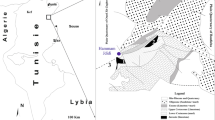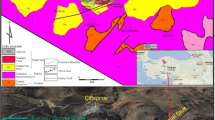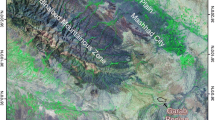Abstract
Shurab travertine spring is located at the beginning of the Gadook defile on the border of Tehran and Mazandaran provinces about 140 km northeastward of Tehran. The carbonate deposits are divided into two main categories: the first group of deposits are forming at the present time (active) and are mostly of different colors such as red, yellow and orange, the second group includes old (fossilized) deposits mainly adjacent to the railway line which are mostly cream colored. The age of these deposits is less than 100 years since they cover part of the railway that was build less than a century ago. This spring comes to the surface through the fractures of the Barut Formation in the railway tunnel. The morphologies of sedimentary deposits are in cascade and layered forms. In this study, 25 samples of travertines and tufas were used to determine the texture and chemical composition of the samples. Based on morphology and depositional environment in their stack, the types of travertines and tufas include: (1) waterfall travertine, (2) travertine with layered morphology, (3) calcareous tufa or framestone phytoherm and lacustrine crusts with oncoids. Also, according to the characteristic morphologies on the field and hand specimen scales in the travertine deposits and based on the petrographic results five types of lithofacies were identified which include: (1) raft boundstone lithofacies; (2) algae lithofacies; (3) crystalline crusts lithofacies; (4) boundstone shrubs lithofacies and (5) oncoid lithofacies. According to the Piper diagram and hydrochemical data, the water in Shurab spring is near neutral to slightly alkaline and of sodium chloride type. These characteristics of the spring water provide the best potential for the water to dissolve carbonates through which the water passes (e.g., Barut Formation dolomites). This study shows that the role of biological activity in the formation of these carbonate deposits is of great importance.





















Similar content being viewed by others
References
Altunel E (2005) Travertines: neotectonic indicators. In: Ozkul M, Yagiz S, Jones B (eds) Travertine, proceedings of 1st international symposium on travertine, Denizli-TurkeyKozan Offset. Ankara, pp 120–127
Altunel E, Hancock PL (1993) Morphology and structural setting of Quaternary travertines at Pamukkale, Turkey. Geol J 28:335–346
Atabey E (2002) The formation of fissure ridge type laminated travertine-tufa deposits microscopical characteristics and diagenesis, Kirsehir Central Anatolia. Bull Mine Res Explor 123–124:59–65
Brogi A, Capezzuoli E (2009) Travertine deposition and faulting: the fault-related travertine fissure-ridge at Terme S. Giovanni, Rapolano Terme (Italy). Int J Earth Sci Geol Rundsch 98:931–947
Capezzuoli E, Gandin A, Pedley M (2014) Decoding tufa and travertine (fresh water carbonates) in the sedimentary record: the state of the art. Sedimentology 61(1):1–21
Chafetz HS, Folk RL (1984) Travertines: depositional morphology and the bacterially constructed constituents. J Sediment Petrol 54:289–316
Chafetz HS, Guidry SA (1999) Bacterial shrubs crystal shrubs and ray-crystal crust bacterially induced vs. abiotic mineral precipitation. Sediment Geol 126:57–74
Chafetz HS, Meredith JC (1983a) Recent travertine pisolites (pisoids) from southeastern Idaho, U.S.A. In: Peryt TM (ed) Coated grains. Springer, New York
Chafetz HS, Meredith JS (1983b) Recent travertine pisoliths (pisoids) from southeastern Idaho, U.S.A. In: Peryt TM (eds) Coated grains. Springer, Berlin, pp 450–455
Claes H, Soete J, Van Noten K, El Desouky H, Marques Erthal M, Vanhaecke F, Ozkul M, Swennen R (2015) Sedimentology, three-dimensional geobody reconstruction and carbon dioxide origin of Pleistocene travertine deposits in the Ballık area (south-west Turkey). Sedimentology 62(5):1408–1445
Claes H, Erthal MM, Soete J, Özkul M, Swennen R (2017) Shrub and pore type classification: Petrography of travertine shrubs from the Ballık-Belevi area (Denizli, SW Turkey). Quatern Int 437:147–163
Davidson J, Hassanzadeh J, Stockli DF, Bashukooh B, Turrin B, Pandamouz A (2004) The geology of Damavand volcano, Alborz Mountains, northern Iran. Geol Soc Am Bull 116:16–29
Drysdale RN (1999) The sedimentological significance of hydropsychid caddis-fly larvae (Order: Trichptera) in a travertine-depositing stream: Louie Creek, Northwest Queensland, Australia. J Sediment Res 69:145–150
Dupraz C, Reid RP, Braissant O, Decho AW, Norman RS, Visscher PT (2009) Processes of carbonate precipitation in modern microbial mats. Earth Sci Rev 96(3):141–162. https://doi.org/10.1016/j.earscirev.2008.10.005
Folk RL, Chafetz HS (1983) Pisoliths (pisoids) in Quaternary travertines of Tivoli, Italy. In: Peryt TM (ed) Coated grains. Springer, New York, pp 474–487
Ford TD, Pedley HM (1996) A review of tuff and travertine deposits of the world. Earth-Sci Rev 41:117–175
Freytet P, Verrecchia EP (1998) Calcitic radial palisadic fabric in freshwater stromatolites: diagenetic and recrystallized feature or physicochemical sinter crust? Sediment Geol 126:97–102
Gandin A, Capezzuoli E (2008) Travertine versus calcareous tufa: distinctive petrologic features and stable isotopes signatures. Ital J Quat Sci 21(1B):125–136
Glover C, Robertson AHF (2003) Origin of tufa (cool-water carbonate) and related terraces in the Antalya area, SW Turkey. Geol J 38:329–358
Goldscheider N, Mádl-Szőnyi J, Erőss A, Schill E (2010) Review: thermal water resources in carbonate rock aquifers. Hydrogeol J 18(6):1303–1318
Goleij F, Mahboubi A, Khanehbad M, Moussavi- Harami R (2018) Sedimentology and hydro-geochemistry of Garab travertines in southeast of Mashhad, Iran. Geopersia 8(2):157–170. https://doi.org/10.22059/geope.2018.248154.648364
Gradzinski M (2010) Factors controlling growth of modern tufa: results of a field experiment. In: Pedley HM, Rogerson M (eds) Tufas and speleothems: unravelling the microbial and physical controls, vol 336. Geological Society London Special Publications, pp 143–191
Gradziński M, Wróblewski W, Duliński M, Hercman H (2013) Earthquake affected development of a travertine ridge. Sedimentology 61:238–263. https://doi.org/10.1111/sed.12086
Grosjean AS, Pittet B (2013) Facies analysis and depositional environments of the Taulanne Limestone Formation in the South Alpine Foreland Basin (Oligocene, southeastern of France). Facies 59:717–736. https://doi.org/10.1007/s10347-012-0350-0
Hancock PL, Chalmers RML, Altunel E, Cakir Z (1999) Travitonics: using travertines in active fault studies. J Struct Geol 21:903–916
Henchiri M (2013) Sedimentology of Quaternary calcareous tufas from Gafsa, southwestern Tunisia. Arab J Geosci 7:2081–2091. https://doi.org/10.1007/s12517-013-0909-2
Huerta P, Armenteros I, Tome OM, Gonzalvez PR, Silva PG, Gonzalez- Aguilera D, Carrasco-Garcia P (2016) 3-D modelling of a fossil tufa outcrop. The example of La Pena del Manto (Soria, Spain). Sed Geol 333:130–146. https://doi.org/10.1016/j.sedgeo.2015.12.013
Janssen A, Swennen R, Podoor N, Keppens E (1999) Biological and diagenetic influence in recent and fossil tufa deposits from Belgium. Sediment Geol 126:75–95
Kanellopoulos C, Thomas C, Xirokostas N, Ariztegui D (2018) Banded Iron Travertines at the Ilia Hot Spring (Greece): an interplay of biotic and abiotic factors leading to a modern Banded Iron Formation analogue? Depos Rec 5:109–130. https://doi.org/10.1002/dep2.55
Kano A, Okumura T, Takashima C, Shiraishi F (2019) Geomicrobiological properties and processes of travertine. Springer Geology, p 176
Keppel MN, Clarke JDA, Halihan T, Love AJ, Werner AD (2011) Mound springs in the arid Lake Eyre South region of South Australia: a new depositional tufa model and its controls. Sed Geol 240:55–70
Khansha J, Amoozegar MA, Ranjbaran M (2016) Studying of Biomineralization on Badab Sourt travertine deposit spring, Kiasar, Mazandaran Province. Biol J Microorg 5(17):141–158 (in Persian)
Khodabakhsh S, Rahmani S, Mohseni H, Kazemi Sh, Ghaemi E (2013) Petrography and geochemistry of quaternary travertines in some sections from N and W Iran. Sediment Facies 6(1):31–48
Kitano Y (1963) Geochemistry of calcareous deposits found in hot springs. J Earth Sci Nagoya Univ 11:68–100
Lopez B, Camion G, Özkul M, Rudy S, Virgone A (2017) Sedimentology of coexisting travertine and tufa deposits in a mounded geothermal spring carbonate system, Obruktepe, Turkey. Sedimentology 64:903–931. https://doi.org/10.1111/sed.12284
Muir-Wood R (1993) Neohydrotectonics. Z Geomorphol 94:275–284
Nordstrom DK, Ball JW, McCleskey RB (2005) Ground water to surface water: chemistry of thermal outflows in Yellowstone National Park. In: Inskeep WP, McDermott TR (eds) Geothermal biology and geochemistry of Yellowstone National Park. Thermal Biology Institute, Montana State University, Bozeman, pp 73–94
Okumura T, Takashima C, Shiraishi F, Nishida S, Yukimura K, Naganuma T, Koike H, Arp G, Kano A (2011) Microbial processes forming daily lamination in an aragonite travertine, Nagano-yu hot spring, southwest Japan. Geomicrobiol J 28:135–148
Okumura T, Takashima C, Shiraishi F, Akmaluddin KA (2012) Textural transition in an aragonite travertine formed under various flow conditions at Pancuran Pitu, Central Java, Indonesia. Sediment Geol 265–266:195–209
Okumura T, Takashima C, Shiraishi F, Nishida S, Kano A (2013) Processes forming daily lamination in a microbe-rich travertine under low flow condition at the Nagano-yu hot spring, southwestern Japan. Geomicrobiol J 30:910–927
Pedley HM (1990) Classification and environmental models of cool freshwater tufas. Sediment Geol 68:143–154
Pedley M (2009) Tufas and travertines of the Mediterranean region: a testing ground for freshwater carbonate concepts and developments. Sedimentology 56(1):221–246
Pedley HM, Andrews J, Ordonez S, Gonzales-Martin JA, Garcia Del Cura MA, Taylor D (1996) Does climate control the morphological fabric of freshwater carbonates? A comparative study of Holocene barrage tufas from Spain and Britain. Palaeogeogr Palaeoclimatol Palaeoecol 121:239–257
Pentecost A (1995) The quaternary travertine deposits of Europe and Asia Minor. Quat Sci Rev 14:1005–1028
Pentecost A (1995) The microbial ecology of some Italian hot-spring travertines. Microbios 81:45–58
Pentecost A (2005) Travertine. Springer, Berlin
Pentecost A, Viles H (1994) A review and reassessment of travertine classification. Geographie physique et Quaternarie 48:305–314
Piper AM (1944) A graphic procedure in the geochemical interpretation of water analysis. Trans Am Geophys Union 25(6):914–928
Rahmani Javanmard S, Toti F, Omidian S, Ranjbaran M (2012) Mineralogy and genesis of fissures hill and vein from Ab-e- Ask based on petrographic studies and carbon- oxygen isotope. Iran J Geol 22:51–61 (in Persian with English abstract)
Rahmani Javanmard S, Toti F, Omidian S, Ranjbaran M (2012) Mineralogy and stable isotope geochemistry of the Ab Ask travertines in Damavand geothermal field, Northeast Tehran, Iran. Cent Eur Geol 55:187–212
Ranjbaran M (2011) Geomorphology and petrography of Badab-e Surt travertine springs north of Damghan, Iran. J New Find Appl Geol 5(9):47–56
Ranjbaran M, Somayeh Rahmani Javanmard S (2019) Petrography and geochemistry of quaternary travertines in the Ab-Ask region Mazandaran Province-Iran. Geopersia 9(2):351–365. https://doi.org/10.22059/GEOPE.2019.269160.648425
Roshanak R, Moore F, Zarasvandi A, Keshavarzi B, Gratzer R (2018) Stable isotope geochemistry and petrography of the Qorveh-Takabtravertines in northwest Iran. Aust J Earth Sci 111(1):064–074. https://doi.org/10.17738/ajes.2018.0005
Salamati MR (2018) Geological map of Firouzkuh, scale 1:250,000. Geological Survey of Iran
Shahbeig A (1993) Mineral and thermal waters of Iran. Geological Survey of Iran
Sotohian F, Ranjbaran M (2015) Depositional system and facies analysis of travertine deposits: Badab-e Surt Spring Mazandaran, Iran. Arab J Geosci 8(7):4939–4947
Uysal T, Feng Y, Zhao J, Isik V, Nuriel P, Golding SD (2009) Hydrothermal CO2 degassing in seismically active zones during the late Quaternary. Chem Geol 265:442–454
Zadsaleh M, Pourkhorsandi H (2016) Quantitative textural investigation of trachyandesites of Damavand volcano (N Iran): insights into the magmatic processes. J Afr Earth Sci 120:238–247
Acknowledgements
We would like to thank college of geology of University of Tehran for the logistic aids. We present our deep gratitude to Neda Bashiri and Mahnaz Hosseinzadeh for their constructive comments and their kind help in fieldwork.
Author information
Authors and Affiliations
Corresponding author
Additional information
Publisher's Note
Springer Nature remains neutral with regard to jurisdictional claims in published maps and institutional affiliations.
Rights and permissions
About this article
Cite this article
Ranjbaran, M., Zamanzadeh, S.M. Determining the role of chemical and biological factors in controlling precipitation of tufa and travertine deposits in Shurab area, Northern Iran. Carbonates Evaporites 36, 73 (2021). https://doi.org/10.1007/s13146-021-00691-z
Accepted:
Published:
DOI: https://doi.org/10.1007/s13146-021-00691-z




